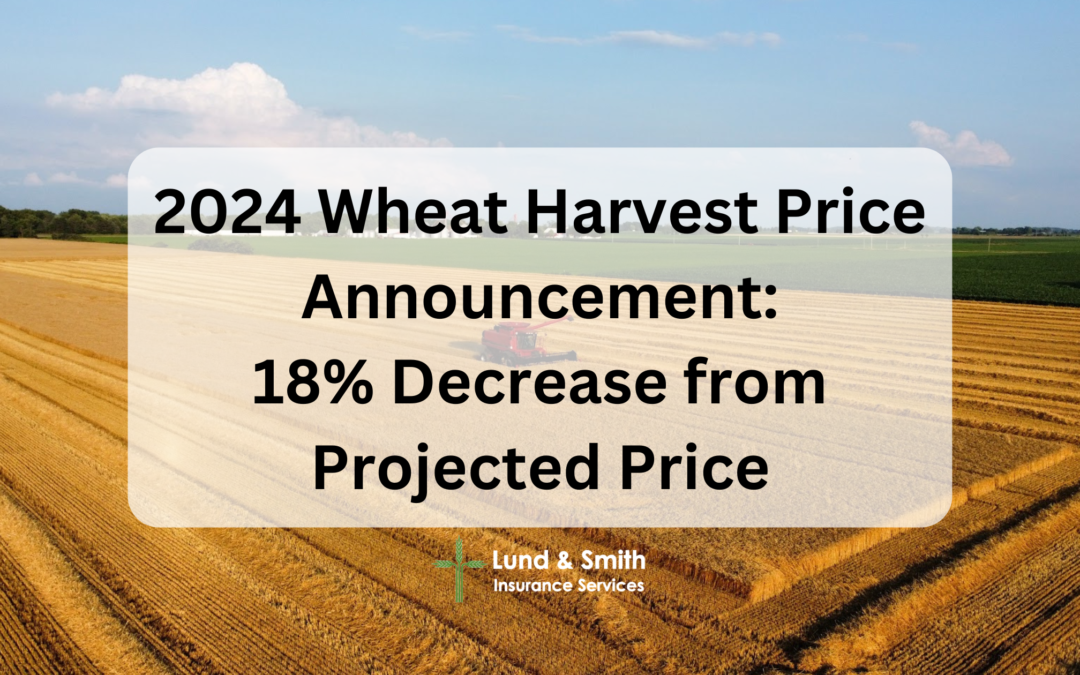At Lund & Smith Insurance Services, we are dedicated to keeping our clients informed about the latest developments that impact each of their operations. We have an important update regarding the harvest price for wheat for 2024. The U.S. Department of Agriculture (USDA) has announced that the harvest price for wheat is set at $5.51 per bushel, reflecting an 18% decrease from the projected price of $6.72 per bushel.
Understanding the Harvest Price
The harvest price is crucial in determining the final indemnities for Revenue Protection (RP) policies. It represents the crop’s market price during the harvest period (7/1-7/31) and is used to compare against the projected price to calculate any potential payouts.
Implications of the Price Decrease
For farmers with Revenue Protection policies, this significant decrease in the harvest price has direct implications. Here’s how:
- Indemnity Calculation: RP policies protect against drops in revenue due to yield loss, price declines, or both. With the harvest price now lower than the projected price, any revenue shortfall will be calculated based on the difference between these prices, adjusted for actual yield. This means that you are guaranteed more bushels to make up for the price decline.
- Increased Coverage for Lower Yields: If your actual yield is lower than your guaranteed yield, the price drop will further increase the indemnity payments, ensuring that your financial stability is protected despite the market fluctuations.
Real-World Example
Let’s illustrate the impact with an example. Consider a farmer, James, who raises some wheat and has an RP policy covering 80% of his Actual Production History (APH). Here’s how the numbers play out:
- James’ APH: 75 bushels per acre
- Projected Price: $6.72 per bushel
- Harvest Price: $5.51 per bushel
- Coverage Level: 80%
Revenue Guarantee Calculation
James’ revenue guarantee is calculated based on the projected price:
- Revenue Guarantee: 80% of APH × Projected Price = 0.80 × 75 bushels/acre = 60 bu/a Trigger Yield.
- 60 bu/a × $6.72 Projected Price = $403.20 per acre guarantee
Updated Loss Trigger Calculation
The updated loss trigger James would receive is then calculated once the harvest price is set. That loss trigger is figured by taking the initial revenue guarantee divided by the harvest price (since the harvest price is lower than the projected price) and you get your trigger yield.
- Loss Trigger: Revenue Guarantee from above / Harvest price = $403.20/$5.51= 73.18 bushels per acre
So anything James harvested below 73.18 bu/a starts paying an indemnity even though his projected revenue guarantee trigger yield is only 60 bu/a. The price decline grows your bushels to meet the same revenue number.
Actual Revenue Calculation
Suppose James averaged 70 bushels per acre across his wheat acres when the combine ran. This is just under his APH and is higher than his initial loss trigger yield by 10 bu/a. Due to the price decline, it still falls below his initial revenue guarantee triggering a loss. His actual revenue at the harvest price is:
- Actual Revenue: 70 bushels/acre × $5.51/bushel = $385.70 per acre
Indemnity Payment Calculation
The indemnity payment James would receive is the difference between his revenue guarantee and his actual revenue:
- Indemnity Payment: $403.20 per acre – $385.70 per acre = $17.50 per acre
Even though James produced more grain than his % coverage of his APH, James still received a payment due to falling below the updated loss trigger of 73.18 bu/a. The harvest price can make quite a difference in these calculations.
Conclusion: Navigating Market Fluctuations
We are committed to helping farmers navigate the complexities of crop insurance and market fluctuations – we all deal with it daily. With the 18% decline in price, you may have triggered a loss even with good yields on your wheat. It is important to get in touch with your agent to let them know what your wheat yielded to make sure you get a claim filed if you fall below that Loss Trigger.
For personalized advice and to learn more about how crop insurance can protect your farming operation, please contact us. We are here to help you make informed decisions and ensure your farm is informed and protected.
Review Your Coverage Options?
Intersted in learning more about Crop Insurance or want to make a switch?

